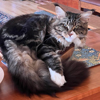A little background, not my first rodeo with myplanner or blade changing.
I have owned my Dewalt DW735 planer for a log time and amvery happy with it. I have changed the blades and serviced the planer severaltimes over the years with no problems. So what went wrong this time?
Background... the blades were old and needed replacement andthe planned was is need of a cleaning. I had planed some short 16" long 11/2" mahogany 12" wide and was surprised the planner with potentiallydulled blades could handle it, but just barely, with very shallow cuts but theblades did the job. I later planed down some painted finger jointed pine doorjambs. To explain, the wood came from a new exterior replacement door jamb butI only need the door and not the jamb. So I though I wood salvage the jambs forsome wine boxes. I have done this type of salvage many time before. Note, Ialso use a good metal detector from Lee Valley (lesson learned a long timeback).
Anyway, on to the problem. After multiple passes on the threepieces of painted finger jointed pine the planer kicked off (reset switch) somethingthat has never happened before. I decided to service the planer, did a completecleaning and flipped the blades over to their unused side, all went as wellusual. I then tested with the 3 foot piece (same pine finger joint, 5"wide) which it seemed to handle with no problem but it came out with 5 majorridges, the kind you get when you chip a blade.
I opened up the planner again and the brand new side of theblades had 5 chips on all three. I immediately checked the wood with the metaldetector and also did a very careful visual inspection. I even tested the metaldetector by introducing a nail, it was working fine. There is nothing I canfind in the finger jointed pine that should have chipped the blade, especial in5 spots. so I then checked the planner blade installation and everything looknormal. One last comment, I think the blades were Powertec not Dewalt butremember I had already been using the other side of the blades previously withno issues.
I will throw away the attempted salvaged pine wood just incase but I don't want to waste another set of blades without knowing what wentwrong. Hence I am reaching out to this group for thoughts.
Can blades be good hardened steel on one side but be badsteel on other the side?
Is it possible I overheated the blades when the planerstalled; but there was no discoloration from over heating
Is it possible that painted finger jointed pine can havesomething non-metallic in the manufacture process that would leave 5 chips inthe planner blades on the first light 3 ft pass
Did I do something wrong in the blade change process; again Ihave done this many time in the past.
Other thought?
A big mystery to me.




 Reply With Quote
Reply With Quote







 I installed a new set of blades and all is back to normal. I did not try testing on the same pine wood which is now cut into shorts in the wood burning bin. expensive firewood!
I installed a new set of blades and all is back to normal. I did not try testing on the same pine wood which is now cut into shorts in the wood burning bin. expensive firewood!